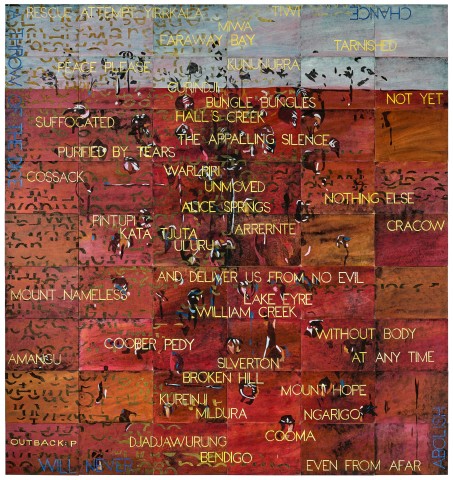OUTBACK: P, 2008
IMANTS TILLERS
synthetic polymer paint and gouache on 54 canvas boards
227.5 x 213.0 cm overall
each panel numbered sequentially with stencil verso: 083448 – 083501
Bett Gallery, Hobart (number BG498)
Private collection, Brisbane, acquired from the above in 2009
Clouds on a Distant Horizon, Bett Gallery, Hobart, 11 March – 21 April 2009
With a large tiled grid of 54 shimmering painted canvas boards, Imants Tillers’ Outback: P, 2008 presents an open landscape, its deep red earth dotted with spindly trees and overlaid with a scatter of text references and place names. The underlying landscape of radiant ochre hues, although not explicitly named, is of the foothills of the Dandenong Ranges in Victoria, specifically a view painted by Fred Williams in 1965 in a similarly large composition currently in the collection of the National Gallery of Australia: Upwey Landscape, 1965 – 66. Tillers’ ‘Outback’ paintings comprise a specific subset of works within the artist’s appropriationist practice. Together they comprise a kind of historiography of western landscape art in Australia, from Glover to Gascoigne, interrogating how the continent has been mythologised in art and language. Landscape is a dominant theme in Tillers’ oeuvre, particularly since moving to the arid countryside of the Monaro region in 1998. His landscape paintings are ‘meditations about landscape’, viewed the prism of Western art history, often looking back to whom he considers to have been ‘the last credible landscape artist: Fred Williams.’1 The Outback works, starting in 2003, are an offshoot of the series ‘Nature Speaks’ (1998 - present) within the artist’s vast anthology of his canvas board works, numbered consecutively since 1981 and collectively titled The Book of Power.
As an interpretation of a historical painted landscape, Tillers’ work speaks to the idea of flux and transience, of different perspectives that have coloured previous attempts to capture the essence of the Australian landscape. A postmodern artist par excellence, Tillers’ longstanding artistic practice has been founded on its devices: appropriation, grid-based enlargement and reproduction and application of text and stencilled overlay on the painted surface. Layering, repetition and variation are central tenets of his practice. Outback: P, like each of the paintings in the larger ‘Nature Speaks’ series (comprising of 159 paintings in 2009) includes the words of the artist’s ‘Mallarméan mantra’,2 taken from a Symbolist poem of free verse and radical typography by Stéphane Mallarmé, Un coup de dés jamais n'abolira le hasard from 1897: ‘a throw of the dice will never abolish chance’ in blue stencilled text. Joining these words is a cascading list of placenames, providing a tangible sense of locality with words which the artist describes as ‘readymade poetry.’3 This list runs vertically down the centre the painting, listing locations from north to south, from Yirrkala and Faraway Bay in the Northern Territory on the top edge of the painting, to Bendigo in Victoria at the bottom. By also including words from David Horton’s map of Aboriginal language groups: Arrernte/Amangu/Kurrenji, Tillers signifies his acknowledgement of the underlying sovereignty of First Nations people.
Included in an exhibition in Hobart in 2009, titled ‘Clouds on distant horizon’, alongside several paintings from the ‘Nature Speaks’ series, Outback: P is a translation of Fred Williams’ distillation of the landscape into a flat and increasingly minimal painterly vocabulary. Tillers has transcribed Fred Williams’ gestures into graphic stencilled silhouettes obscured under a textural pattern of fragmented metallic lettering. Although Tillers has retained the high horizon of Williams’ original painting and through his own artistic techniques augmented its compressed depth of field and glowing layers of red-ochre and golden brown, the finished work bears little resemblance to Upwey Landscape. Instead it joins Tillers’ grand conceptual project. Like its siblings, this perceptive painting solicits deep reflection on how the painted landscape informs our collective conception of the physical landscape and forges our national identity.
1. Imants Tillers, 9 April 2012, see: https://www.artgallery.nsw.gov.au/prizes/wynne/2012/29209 (accessed March 2024)
2. Tillers, I., ‘When Locality Prevails’, Heat, No. 8, 2004, p. 115
3. ibid.
LUCIE REEVES-SMITH

